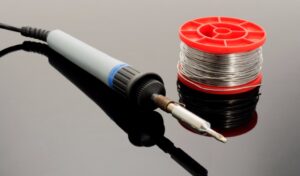Ever wonder to have your own electronics lab? Almost every hobbyist fancies having his / her own mini-lab in his home. In this post, we’ll see some of the most important tools you must have in your mini-lab for starting experimentation.
1. Soldering Iron

The concept of electronics hobby lab begins with soldering iron itself. Soldering iron is a small welding machine which can melt the soldering metal used for soldering electronic components on a Printed Circuit board. Having a soldering iron with you opens a lot of things for you to experiment with. With a soldering iron at home, you can also quickly solder minor issues in your tv remote or some cut wires in your hobby project or make changes to an existing project. Soldering iron comes in a variety of options, 25Watt, 30Watt, 50Watt and so on. Also, there are a variety of soldering stations which are temperature-controlled and can give you constant temperature all the time, but stations are costly and irons are cheaper. So if you’re a beginner a good quality soldering iron is all you need. (of course with a bundle of solder metal)
2. Common Electronics Components
Why do we setup an electronics lab? To experiment with, right? And what to experiment with if you have no components at all? So the second in this list is having common electronics components at your disposal for creating projects or replacing parts from any existing PCB. Some of the common parts that you must keep in your stock are listed below.
Resistors: Different values from 10-ohm, 39 ohm, 100 ohm, 330 ohm, 470 ohm, 1k, 1.5k, 3.3k, 4.7k, 10k, 33k, 22k, 47k, 100k, 1M, 10M and 100M are few common values to begin with
Capacitors: Capacitors are good for creating power supplies and connecting in number of different circuits, you should have these values in stock, 1nano farad or nF, 10nF, 100 nF, 0.1uF, 1 uF, 10 uF, 47 uF, 100 uF, 470 uF, 1000 uF
Transistors: Both NPN and PNP transistors are good to have in stock like BC548, BC557 as well as some high current transistors like BD139 and MOSFETs like Z44
Diodes: useful for making power supplies and electronics switches, you should have at least one type of rectifier diode and one switching diode and few Zener diodes, Values are 1N4001 and 4148 to name a couple
3. Zero PCBs or General Purpose PCB

This is a general purpose PCB on which you can mount your components and make circuit connections. Ideally suited for creating a complete test circuit. Unlike printed circuit board, this PCB does not have any thing printed on it and hence there are no interconnections. Instead, it has number of different individual holes NOT connected to any other hole, so you can make the interconnects by simply using some long wires of sufficient length
4. Breadboard

Making circuits on a board requires lots of time and special skills. For a long time, scientists and engineers rely on a simple method to develop any circuit. In this technique, circuit is built on something called breadboard!!! Confused? Actually, a breadboard is a rectangular board which is having lots of HOLES to place electronic components in it. The holes in a breadboard are interconnected in such a manner that makes the connection of components easier. Still, for making additional connections, we need simple single strand wire. This is the wire which has only one thick thread inside the insulation. To know about details of how to use a breadboard, you can refer to this article here
5. Connecting wires

These are used for interconnecting components on zero PCB or making connections on a breadboard or for simply having things connected with each other without soldering. Connecting wires in all formats should be present in small quantity, format means: Single stand wire, multistrand wire, M-M connectors, and F-F connectors
6. Digital Multimeter

Digital Multimeter is one of the most essential tools an electronics hobbyist should own. While developing electronics circuits, we come across lots of different parameters which needs to be checked, for example, voltage, current, resistance, continuity etc… there are separate instruments available for each of these parameters, and multimeter is the one instrument having facility for doing all above measurement. There are analog and digital multimeters available. But digital are becoming more common these days and hence we use digital multimeters, which is also referred as DMM. Now and onwards, we use simply multimeter for referring to a DMM. It’s basically a measuring instrument which can measure.
To learn in detail about how to use a digital multimeter, you can refer the tutorial here
7. Wire Cutter / Stripper

Lastly a wire cutter and a stripper will help you cutting the leads on pcb’s and cutting your wires in desired length. This mechanical tool is one of the very important tools you should have in your arsenal
8. Batteries / Power Supply

For quickly prototyping with electronics circuits, couple of 1.5 and 9v batteries are must have in the stock. They help us in powering number of different circuits and testing them out as and when required. If you don’t have batteries, at least have a wall adapter giving out a standard 12v DC voltage. What we need is a dc power source no matter how it comes from either batteries or adapter. And for those who do lot of works on breadboard, having a breadboard power supply is also a good thing. If you want to create your own power supply, follow this tutorial here
On our courses page, you can see lots of interesting online courses for more deeper understanding of technologies here


